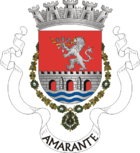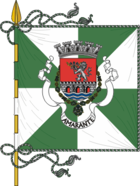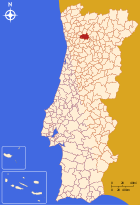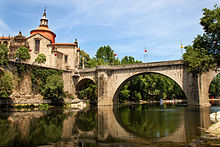Amarante
| Amarante | ||||||
|---|---|---|---|---|---|---|
|
||||||
| Basic data | ||||||
| Region : | Norte | |||||
| Sub-region : | Tâmega e Sousa | |||||
| District : | postage | |||||
| Concelho : | Amarante | |||||
| Coordinates : | 41 ° 16 ′ N , 8 ° 4 ′ W | |||||
| Residents: | 56,264 (as of June 30, 2011) | |||||
| Surface: | 301.3 km² (as of January 1, 2010) | |||||
| Population density : | 187 inhabitants per km² | |||||
| Amarante district | ||||||
|
||||||
| Residents: | 56,264 (as of June 30, 2011) | |||||
| Surface: | 301.3 km² (as of January 1, 2010) | |||||
| Population density : | 187 inhabitants per km² | |||||
| Number of municipalities : | 26th | |||||
| administration | ||||||
| Administration address: | Câmara Municipal de Amarante Alameda Teixeira de Pascoaes 4600-011 Amarante |
|||||
| President of the Câmara Municipal: | José Luís Gaspar ( PSD / CDS ) | |||||
| Website: | www.cm-amarante.pt | |||||
Amarante [ ɐmɐˈɾɐ̃tɯ ] is a city in the Portuguese region of Norte with about 9,900 inhabitants. It is located on the Tâmega , a tributary of the Douro .
history
Archaeological finds prove a settlement since the Paleolithic , especially from the Bronze Age numerous finds come here. The place name probably goes back to the name Villa Amaranthi , in connection with the local estate ( Villa rustica ) of the Roman general Amarantus. Another explanation of the place name, which also goes back to Roman times, sees the term ad Maranus (Latin for “near the Marão mountains”) as its origin. Another theory that can be found in the city history published in 1814 leads the place name to the place here around 360 BC. BC by the Celtiberian Turdul founded place Araduca . According to this, the Roman general Seneciones took the nickname Amarantus after conquering the place, from Ante Maranum (Latin for "in front of the Maranus Mountains", today Marão ).
The place was first known through the work of St. Gonçalo de Amarante (Portuguese also São Gonçalo , 1187–1259). The Dominican from Vizela settled here after his pilgrimages to Jerusalem and Rome in the second half of the 12th century. Among other things, the place owes its famous bridge over the Tâmega to him. As a result of his diverse work, Amarante developed into a place of pilgrimage with a growing population. In the 16th century, King John III made it possible . the construction of the São Gonçalo monastery at the place where religious priests worked and were buried.
In the course of the Napoleonic invasions at the beginning of the 19th century, Amarante suffered severe damage. The successful defense of the strategically important bridge on April 18, 1809 under the leadership of the Portuguese officer Silveira, who subsequently received the title of Count de Amarante, became known. In addition, since then Amarante has been wearing the Order of the Tower and the Sword in the city's coat of arms , which the small town was subsequently awarded.
The Amarante district experienced significant expansions in the course of the various administrative reforms after the Liberal Revolution in 1822 , when the previously independent districts of Gestaço, Gouveia and Santa Cruz de Riba Tâmega were dissolved.
In the 20th century, various writers, painters and other artists from Amarante enriched the country's cultural life, including Teixeira de Pascoaes and Amadeo de Souza-Cardoso . On July 8, 1985, the previous small town ( Vila ) Amarante was elevated to a city ( Cidade ), the date is now a municipal holiday.
Culture
- The Museu Municipal Amadeo de Souza-Cardoso shows works by the painter Amadeo de Souza-Cardoso (1887–1918), who was born in neighboring Mancelos .
economy
The Amarante district is characterized by agriculture. Viticulture is of particular importance, mainly through the Vinho Verde . Companies in the wood processing, construction, metal processing and food industries are based in industrial companies. The international construction company Mota-Engil , one of the 50 largest in Europe, comes from Amarante and is still based here, although the main administration is now in Porto.
Tourism in the district has gained in importance, both through hotel operations and through facilities of the rural tourism . The local handicrafts are also known nationwide . In addition to knitwear and pottery, particular mention should be made of the wickerwork, which, among other things, makes the baskets originally required for the grape harvest.
traffic
Until 2009, Amarante was connected to the country's rail network via Linha do Tâmega , which opened in 1909 . The line was discontinued and replaced by bus services.
The city is located on the A4 motorway , which runs from the coastal town of Matosinhos in the greater Porto area via Vila Real and Bragança to the Spanish border. Amarante is also connected to Guimarães, 40 km to the north, and Peso da Régua , 40 km to the south, via the N101 national road .
administration
Amarante district
Amarante is the seat of a district of the same name ( concelho ) in the Porto district . On June 30, 2011 it had 56,264 inhabitants on an area of 301.3 km².
The neighboring areas are (starting clockwise in the north): Celorico de Basto , Mondim de Basto , Vila Real , Santa Marta de Penaguião , Baião , Marco de Canaveses , Penafiel , Lousada and Felgueiras .
With the regional reform in September 2013, several municipalities were merged into new municipalities, so that their number decreased from 40 to 26.
The municipality of Amarante includes the following municipalities ( Freguesias ) :
| local community | Population (2011) |
Area km² |
Density of population / km² |
LAU code |
|---|---|---|---|---|
| Aboadela, Sanche e Várzea | 1,675 | 30.45 | 55 | 130141 |
| Amarante (São Gonçalo), Madalena, Cepelos e Gatão | 11,840 | 15.21 | 778 | 130142 |
| Ansiães | 623 | 27.19 | 23 | 130103 |
| Bustelo, Carneiro e Carvalho de Rei | 1,019 | 23.43 | 43 | 130143 |
| Candemil | 771 | 12.01 | 64 | 130107 |
| Figueiró (Santiago e Santa Cristina) | 3,828 | 8.11 | 472 | 130144 |
| Fregim | 2,836 | 10.37 | 274 | 130112 |
| Freixo de Cima e de Baixo | 3,643 | 8.81 | 413 | 130145 |
| Fridão | 863 | 7.87 | 110 | 130115 |
| Gondar | 1,686 | 9.64 | 175 | 130117 |
| Jazz | 542 | 3.35 | 162 | 130118 |
| Lomba | 793 | 3.63 | 218 | 130119 |
| Louredo | 638 | 3.60 | 177 | 130120 |
| Lufrei | 1,777 | 6.45 | 275 | 130121 |
| Mancelos | 3.114 | 12.13 | 257 | 130123 |
| Olo e Canadelo | 492 | 19.51 | 25th | 130146 |
| Padronelo | 884 | 2.48 | 356 | 130126 |
| Real, Ataíde e Oliveira | 5,006 | 10.96 | 457 | 130147 |
| Rebordelo | 365 | 15.66 | 23 | 130128 |
| Salvador do Monte | 1,066 | 7.48 | 143 | 130129 |
| Sao Simão de Gouveia | 633 | 12.49 | 51 | 130134 |
| Teloes | 4,226 | 14.47 | 292 | 130135 |
| Travanca | 2,278 | 8.69 | 262 | 130136 |
| Vila Caiz | 3,026 | 8.52 | 355 | 130138 |
| Vila Chã do Marão | 940 | 6.71 | 140 | 130139 |
| Vila Garcia, Aboim e Chapa | 1,700 | 12.08 | 141 | 130148 |
| Amarante district | 56,264 | 301.30 | 187 | 1301 |
Population development
| Population in Amarante County (1801–2011) | ||||||||
|---|---|---|---|---|---|---|---|---|
| 1801 | 1849 | 1900 | 1930 | 1960 | 1981 | 1991 | 2001 | 2011 |
| 1,416 | 15,918 | 32,931 | 37,796 | 47,823 | 54,159 | 56.092 | 59,638 | 56,450 |
Municipal holiday
- 8th of July
Town twinning
sons and daughters of the town
- Mafalda of Portugal (probably 1200–1257), Portuguese princess, Castilian queen and nun, blessed
- Alberto de São Gonçalo da Silva (1631–1688), Archbishop of Goa in Portuguese India
- Antônio de Guadalupe (1672–1740), bishop in Rio de Janeiro and in Viseu
- Paulino António Cabral (1719–1789), spiritual writer and lawyer who became known as the “Abbot of Jazente ”
- António da Trindade de Vasconcelos Pereira de Melo (1812–1895), bishop in Beja and Lamego
- José Guedes de Carvalho e Meneses (1814–1879), aristocratic military and colonial administrator, governor of Cape Verde and Mozambique
- António Cândido Ribeiro da Costa (1850–1922), lawyer, theologian, philosopher and politician, multiple minister
- António Carneiro (1872–1930), painter
- Teixeira de Pascoaes (1877–1952), poet and mystic
- Acácio Lino (1878–1956), painter
- Artur Carlos de Barros Basto (1887–1961), military and Jewish author, officer in the Portuguese Expeditionary Corps in World War I, founder of the Sinagoga Kadoorie and the Jewish community of Porto
- Augusto Casimiro (1889–1967), writer and journalist, member of the opposition to the Estado Novo regime
- Agustina Bessa-Luís (1922–2019), writer
- Alexandre Maria Pinheiro Torres (1923–1999), neorealist writer, literary historian and literary critic
- Eduardo Teixeira Pinto (1933–2009), photographer
- António Marinho Pinto (* 1950), President of the Portuguese Bar Association
- Francisco Assis (* 1965), politician
- António Pinto (* 1966), Olympic athlete
- Nuno Gomes (* 1976), football player
- Renato Queirós (* 1977), football player
- Delfim José Fernandes Rola Teixeira (* 1977), football player
- Ricardo Carvalho (* 1978), football player
- Rui Andrade (* 1985), actor and singer
- Miguel Vieira (* 1990), football player
Ricardo Carvalho in the Real Madrid shirt , 2010
Others
On April 16, 1997, an arson attack was carried out on a discotheque, killing twelve people. It is believed that the assassin can be attributed to the pimp milieu. Exactly three years later to the day, a similar incident occurred due to poison gas in a discotheque in Lisbon , in which seven people died and 65 were injured.
Web links
- Page around Amarante (port.)
- Official website of the city administration (port.)
- Site of the Museu Amadeo de Souza-Cardoso (Eng. And Port.)
- Photos from Amarante on Flickr
Individual evidence
- ↑ a b c www.ine.pt - indicator resident population by place of residence and sex; Decennial in the database of the Instituto Nacional de Estatística
- ↑ a b Overview of code assignments from Freguesias on epp.eurostat.ec.europa.eu
- ^ João Fonseca: Dicionário do Nome das Terras . 2nd edition, Casa das Letras, Cruz Quebrada 2007, p. 32 ( ISBN 978-972-46-1730-5 )
- ↑ www.verportugal.net , accessed December 9, 2013
- ↑ ditto
- ^ Publication of the administrative reorganization in the Diário da República gazette of January 28, 2013, accessed on March 16, 2014
- ↑ www.anmp.pt , accessed December 12, 2013
- ↑ Juiz decide libertar um dos condenados pelas mortes do Meia Culpa 17 anos depois
- ↑ Tribunal analisa novo pedido de liberdade condicional do mandante do massacre do Mea Culpa
- ↑ Poison gas attack on disco - seven dead!

















